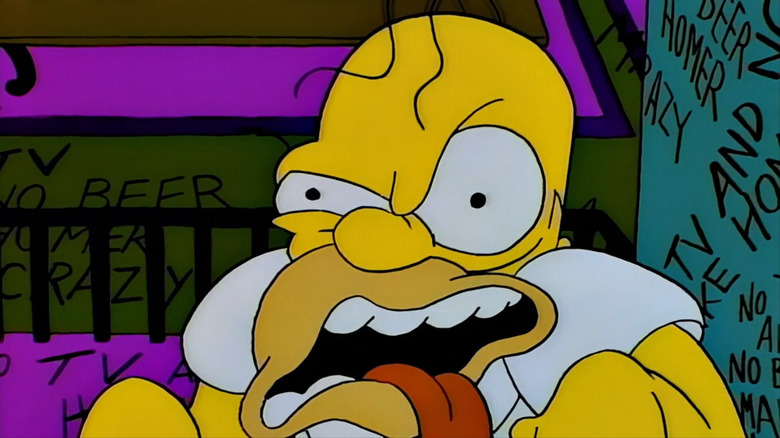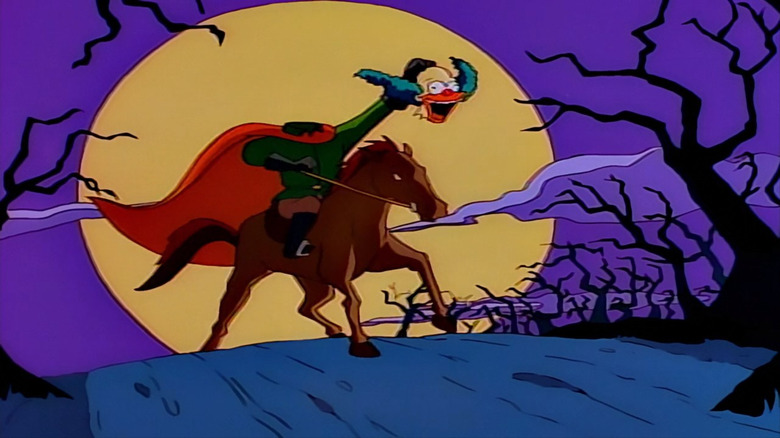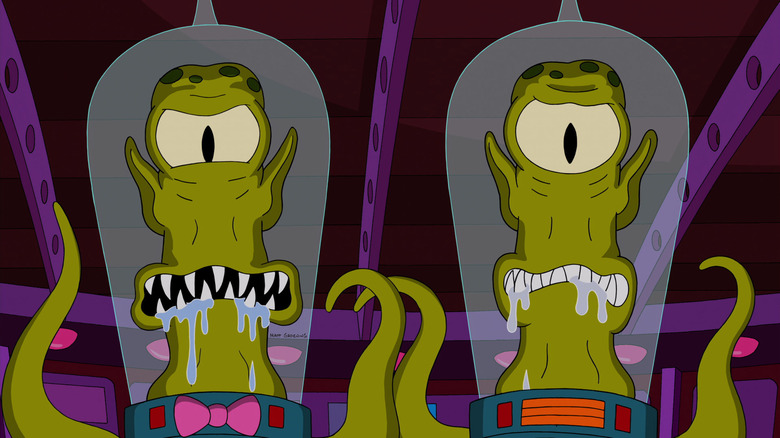It Takes A Scary Amount Of Work To Make A Simpsons Treehouse Of Horror
The first "Simpsons" Halloween special, first aired on October 25, 1990, was a banner event for the rising tide of "Simpsons" fans. Many a youth rushed to their VCRs that evening, eager to capture on tape an event unprecedented in the show. While "The Simpsons" typically had fewer structural rules than its live-action sitcom counterparts, it was still set in a relatively recognizable world. The Halloween special promised a visit to the supernatural, a tantalizing event to say the least. "The Simpsons" and "Tales from the Crypt" were going to bleed into one another.
1990 was a good time to be a "Simpsons" fan. In addition to the Halloween special, that was also the year that saw the release of the hit album "The Simpsons Sing the Blues." It would only be a few months later that the music video for "Do the Bartman," a single co-written by Michael Jackson, would premiere on TV. All of these could be watched while wearing a then-novel "Bart Simpson: Underachiever" T-shirt.
Of course, the first Halloween special was such a hit that the practice soon became an annual tradition. In October of 2022, the 33rd — and bonus 33½th — "Treehouse of Horror" will air. And while the airing of the specials is a cause célèbre for "Simpsons" fans, it's a huge headache for the makers of the show. Following the model of the 1990 special, almost all of the "Treehouses" have been presented as triptychs, sometimes with linking "host" segments. That means each special typically required three times the work.
For the Archive of American Television in 2013, longtime "Simpsons" producer Al Jean described just how hard the animators worked to make those specials, and what exactly goes into each one.
The production schedule
Al Jean starts by pointing out a very basic notion of how modern animation production works. "The Simpsons" would need to draw each background by hand, of course, meaning if any details were included in one scene, they would need to be redrawn entirely for another. The drawings would then be sent to the animation studio (beginning with the show's fourth season, it would be the Korean studio Rough Draft) and animated. This production schedule limited what could be made in a week's episode, as the Korean studio would more hastily return the tightly schedules episodes if they could simply reuse stock backgrounds. The example Jean gives is in reference to a pair of jokey video games seen in the background of a shot of a convenience store:
"With the animation, you look at the Kwik-E-Mart, there's like the game called 'Time Waster' and a game called 'Grand Theft Walrus." What you have to do is, you have to say to the Korean animation house, 'We can use the standard Kwik-E-Mart background,' because otherwise it would just be prohibitive; you'd have to be doing new designs. That's why, for example, our Halloween show takes a year to do. Because you're designing everything again, you know, three times for those segments."
Incidentally, other games that have appeared at the Kwik-E-Mart have been "Escape from Death Row," "Cat Fight," "Devil's Advocate," "Great White Hunter," "Hockey Dad," "Killer Joe" (no relation to the William Friedkin movie), and "NUKE."
The Halloween timeline
Because the Halloween specials were so labor intensive, Jean reveals that they literally took all year to make. The timeline on any given "Treehouse of Horror" began as early as the previous Halloween. As the years have passed, the specials have gotten more and more elaborate, to the point where horror began to fall by the wayside, and wild new animation styles took precedence. This was in addition to hiring guest filmmakers to become help design "Simpsons" opening sequences (the 2014 sequence from animator Don Hertzfeldt remains a highlight). As Jean describes, getting Guillermo del Toro involved for one special required a redesign of every "Simpsons" character:
"Usually we write the Halloween show the previous Halloween ... And, you know, it's definitely one of the most work-intensive shows of the year for the writers, and especially the director and the rest of the animators ... Then there's a couch gag that references basically every horror movie ever made, which was guest-directed by Guillermo del Toro. Each one of them is like doing a whole episode in five minutes. That one [has] gotta have the most hours put into it of anything we've done this year."
The del Toro sequence, incidentally, appeared at the head of "Treehouse of Horror XXIV," which aired in 2013.
"The Simpsons" has only become more and more elaborate as the years pass, and that 1990 Halloween special almost seems quaint, even crude, compared to what Del Toro provided. The early specials, however, still possess a scrappy, scary charm that can lend a little horror-twinged boost to any Halloween gathering. And, thanks to the caprices of streaming, all of them can now be viewed as a Halloween marathon.


